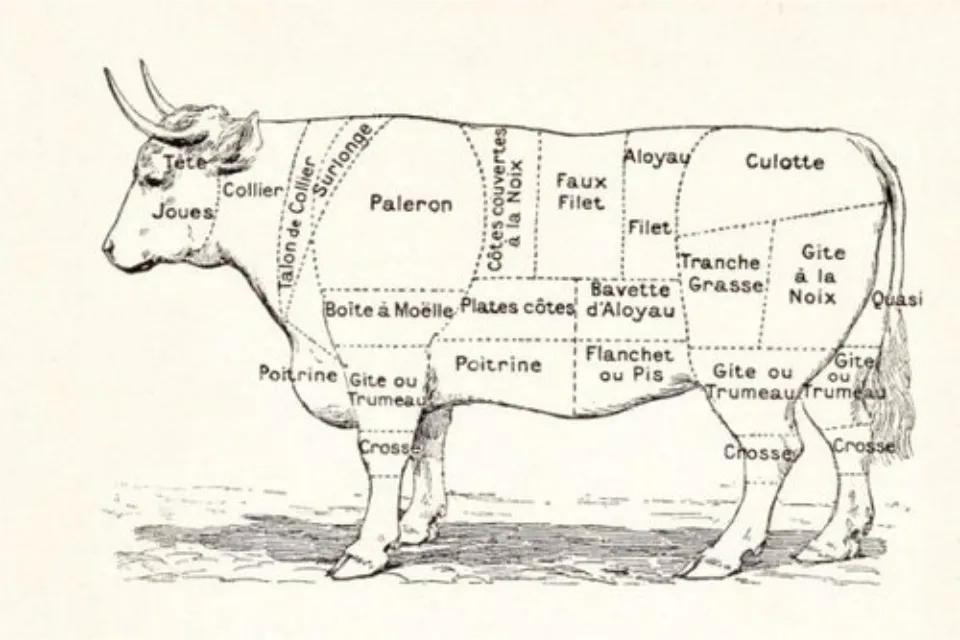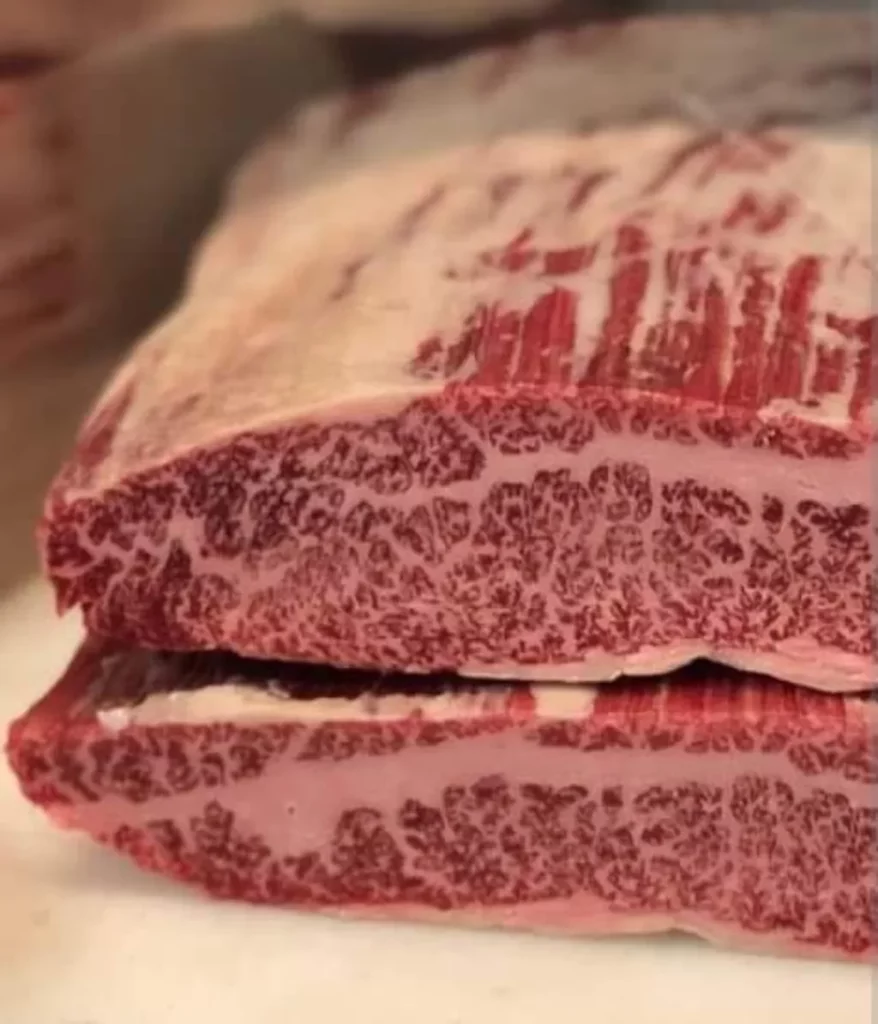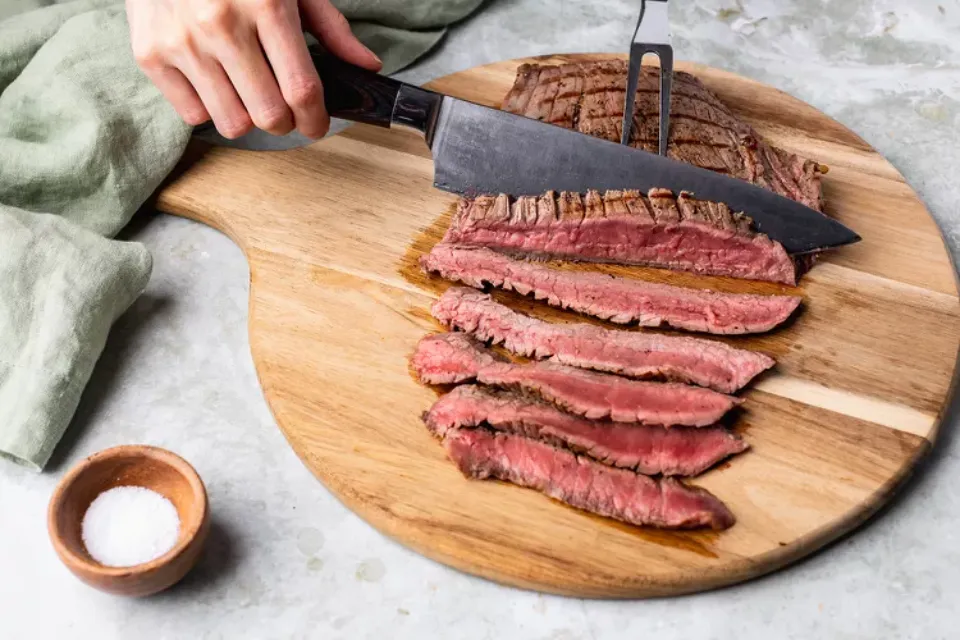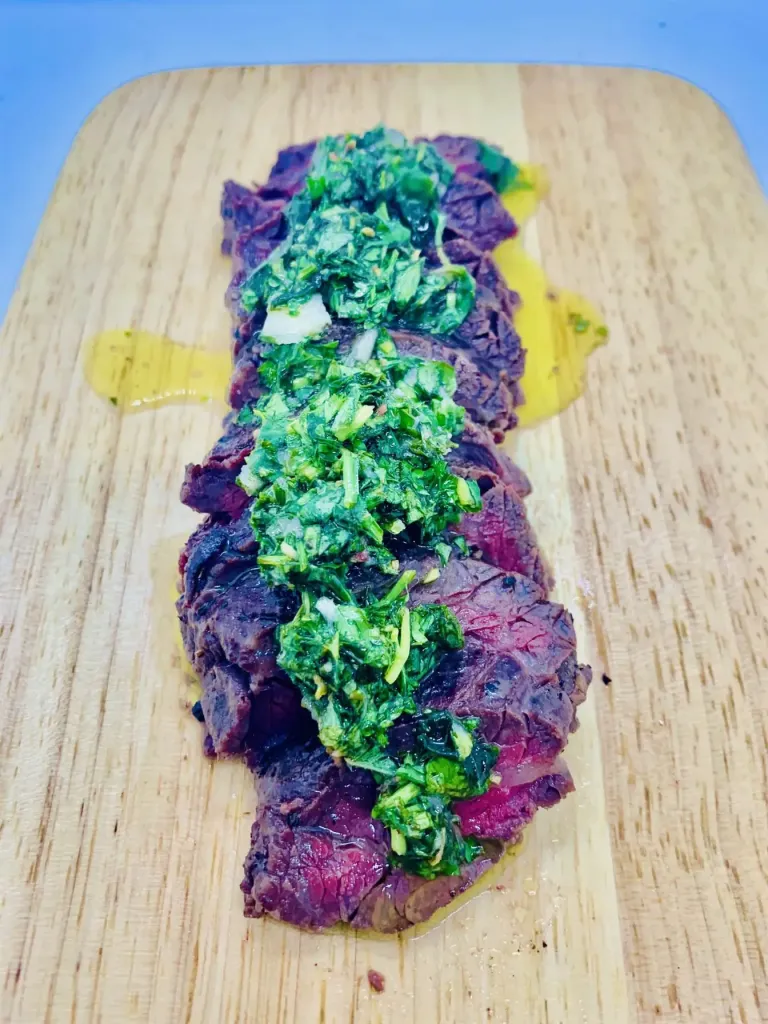Bavette Steak Guide Contents
Introduction
Attention my fellow steak enthusiasts and flavor seekers! Get ready to meet the unsung hero of beef: the Bavette Steak. This cut is a true game-changer when it comes to flavor and tenderness. Picture a steak that’s flat, flexible, and packed with just the right amount of muscle and fat.
Sounds mouthwatering, right? It is literally some of the tastiest beef cut you’ll ever have, on par if not better than ribeye and even competing with our friend Wagyu Beef (but yes, you can also get Wagyu Bavette Steak). Read on folks, it gets better and better.
Now, you might be wondering, what sets this steak apart from the crowd? Let me tell you a little secret—it’s all about location, location, location! The Bavette comes from the bottom sirloin, nestled at the intersection of the sirloin, short loin, and flank.
This prime spot means the meat is tender, thanks to less muscle exercise and a better fat ratio. It’s like a well-deserved vacation for your taste buds!

In fact, this family of steak cuts from the lower abdominal muscles is some of my absolute favorites to cook with, outside of Tomahawks of course. This steak sits in this steak-location family that includes:
- Flank Steak,
- Onglet Steak,
- Skirt Steak, and of course
- Bavette.

But hold on, there’s more to this story. If you’re thinking of picking up a Bavette at your local supermarket, think again. This cut has earned the nickname “the butcher’s cut” because butchers often keep it for themselves. However, fear not! Your friendly neighborhood butcher should have this treasure on hand, ready to unleash its delectable potential. But, I am also seeing this available much more freely now in supermarkets: perhaps the word is out about just how good this steak cut is.
Now, let me answer the burning question: Why should you keep reading? The short answer: Bavette Steak is a flavor-packed delight that deserves a spot on your plate. But that’s just the beginning! In this article, we’ll dive deeper into the art of cooking the steak to perfection. We’ll explore its versatility, share ISLIFEARECIPE.net tips for seasoning and grilling, and even uncover some of our mouthwatering marinade and sauce options.
So, whether you’re a grill master or a culinary adventurer, prepare for a tantalizing journey that will leave your taste buds begging for more. We’re going to explain how to prepare and select, perfect cooking techniques, seasonings, accompaniments, and even FOUR ISLIFEARECIPE.net recipes for this incredible meat cut. Read on…
What is Bavette Steak?
It is also sometimes known, incorrectly, as Flap Steak, Goose Skirt, or Flank Steakv. It does, however, share similarities with Flank Steak and Skirt Steak in looks, but offers even more robust and succulent flavors.
Once discarded at the abattoir, it is a flavorful, well-textured, and versatile cut of beef that comes from the lower chest or abdominal muscles of the cow. It is a long, flat cut of meat with a coarse texture and distinct grain. The steak is renowned by Chefs for its rich, beefy flavor and can be quite tender if cooked and sliced properly. It is popular in various cuisines and can be prepared using different cooking methods.
In summary, the steak is referred to by so many different names, even Wagyu Bavette, Steak Bavette, Beef Bavette, or Sirloin Bavette. Regardless of the name, one thing remains constant—its exceptional taste brings versatility to the culinary world.
The Distinctive Qualities of Bavette Steak
The steak stands out due to its remarkable combination of rich flavors and tenderness. As it comes from the cow’s lower hindquarters, it possesses a well-developed beefy taste that pairs perfectly with bold seasonings, marinades, and sauces. When cooked to perfection, it boasts a juicy and melt-in-your-mouth texture that is sure to please even the most discerning steak aficionados.
The open-grain structure has two key benefits:
- It helps make the steak incredibly tender since the muscle fibers are not tightly bound to each other.
- The openness lets this steak really soak up marinades.
Choosing the Perfect Bavette Steak
When selecting Bavette Steak, it is important to consider a few key factors to ensure optimal quality and taste. Look for cuts that have a vibrant red color and are well-marbled with thin streaks of fat throughout the meat. This marbling contributes to the steak’s tenderness and enhances its natural flavors. Additionally, choose steaks that are approximately 1 to 1.5 inches thick for ideal cooking results.
When choosing Bavette Steak, opt for a dry-aged variety if available and on budget. While it may be slightly more expensive, dry-aged steak offers a deeper and more complex flavor profile. Look for a thicker cut of Bavette Steak to prevent overcooking and maintain juiciness. The presence of marbling ensures the meat remains succulent and imparts a robust beefy taste. You can anticipate a particularly “beefy” flavor from this cut because fat is a great flavor transporter.
Always though keep an eye out for any ‘silver skin’, which is a white layer of extremely tough connective tissue commonly found on beef. It’s tough, chewy, and doesn’t melt during cooking as fat does, so silverskin must be removed before cooking, or source your Bavette cleaned of it already.
Wagyu Bavette and Flank Steak

The marbling in American Wagyu Bavette adds richness and enhances the overall flavor profile. Whether you’re hosting a gathering or treating yourself to a special meal, Bavette is a fantastic choice, so why not up the ante and get those Wagyu overtones working in your favor as well?
USDA Wagyu Bavette Steak is a unique and flavorful cut of beef that has gained popularity in recent years. Although not very common, Bavette Steak offers a delicious alternative to more well-known cuts of beef.
One of the distinguishing features of USDA Wagyu Bavette Steak is its marbling. It is usually finely marbled, resulting in a tender and juicy texture. The marbling also contributes to the rich flavor of the steak, making it a favorite among steak enthusiasts. When purchasing Bavette Steak, look for even marbling throughout the cut, with long muscle fibers visible. I’d definitely give Snake River Farms Wagyu a bash.
Preparing Bavette Steak for Cooking
Before cooking your steak, it is essential to properly prepare the meat to enhance its flavor and tenderness. Start by removing the steak from the refrigerator and allowing it to come to room temperature. This helps ensure even cooking and prevents the steak from becoming tough.
Next, season the steak generously with sea salt and cracked Kampot black pepper (killer with this steak cut due to the citrus, and floral tones) or your preferred seasoning blend, allowing the flavors to penetrate the meat.
Here are some of the reasons why Bavette Steak is a great choice
- It is a cheap cut of meat (I like it…),
- It is extreme on the flavorful front,
- It is versatile and can be cooked in a variety of ways, as you’ll see below, and
- It is a good source of protein.
Cooking Techniques for Bavette Steak
Bavette Steak can be cooked using various techniques, each offering a unique culinary experience. Here, we explore THREE of our popular methods: BBQ Grilling, Skillet Pan-Searing, and Broiling. The best and only way (in my humble opinion) to cook Bavette is over high heat on a cast-iron skillet until it is either rare or, at most, medium rare. It’s such a thin steak you can overcook it so easily in more ‘un-controlled’ cooking environments like direct BBQ.
Hey, kill two birds with one stone and throw your skillet on the BBQ.
Bavette should always be ‘treated‘ before cooking because of the cut’s fibrous quality. Bavette really benefits from some attention before it hits the pan, whether this be physical, in the form of tenderizing with a meat hammer or bashing with a rolling pin, or chemically, in the form of a marinade, brine, or rub.
Bavette Steak can be cooked using various methods, each offering a unique culinary experience. Here are THREE popular cooking methods for cooking this steak:
BBQ Grilling Bavette Steak
BBQ Grilling Bavette Steak is an excellent way to achieve a charred and smoky flavor while preserving its juiciness. Preheat your BBQ grill to medium-high heat and oil the grates to prevent sticking. Not the steak, just the grill.
Place the steak on the grates and cook for about 1-2 minutes per side, depending on the desired level of doneness. Use an instant-read thermometer to ensure the internal temperature reaches around 130°F (or 55°C) for a medium-rare result. Let it have that 10-minute rest afterward.
Pan Searing Bavette Steak
Another option is to pan-sear the Bavette Steak: This is my favorite technique as the steak is quite thin. Heat a hot cast iron pan to smoking and sear the steak, flipping it often until the desired doneness is achieved. This method allows for a nice sear on the outside while ensuring the interior is cooked to your preference. 1-2 minutes tops for medium rare, then rest. of course, you need to season first with sea salt and cracked Kampot black pepper.

Broiling Bavette Steak
If you don’t have access to a grill or prefer an indoor cooking method, you can use the broiler in your oven. Move the oven rack to a higher position, set the broiler to high, and place the steak on a broiler pan or cooking rack. Cook the steak under the broiler, flipping it occasionally, until it reaches the desired level of doneness. Make sure you season first with sea salt and cracked Kampot black pepper.
ISLIFEARECIPE.net Cooking Tip
Remember to let the cooked Bavette Steak rest for about 10 minutes before slicing, no matter how you cook it. This allows the juices to redistribute and ensures a more flavorful and tender steak.
How To Slice Bavette Steak
When it comes to serving Bavette Steak, it is typically sliced against the grain, which helps to break up the muscle fibers and make it more tender to chew. If cut right, this cut of beef is versatile and can be used in various dishes such as stir-fries, fajitas, and sandwiches, or served as a main course alongside vegetables and potatoes: see below.

Just to close this topic down, when I say: “is typically sliced against the grain”, I actually mean you MUST cut across the grain. It is THE must with these fibrous steaks cut from this region of the cow. You’ll then have melt-in-the-mouth steak, not long stringy, chewy, bubble-gum steaks.
Flavorful Seasonings, Marinades, and Accompanying Sides
Due to the fibrous nature of the steak, it benefits from some preparation before cooking. Tenderizing the meat with a meat hammer or marinating it enhances its tenderness and infuses it with additional flavors. A dry rub can be used when grilling, and brining or marinating with acidic ingredients such as citrus, vinegar, or yogurt helps tenderize the meat.
We could write a whole other blog on this topic: meat tenderization… top tips…

ISLIFEARECIPE.net top tip
Here’s a food hack you may never have tried: Pop your steak in a zip-lock bag and add some fresh Papaya or Pineapple. The acid in the fruit acts as a natural tenderizer and adds some super-cool flavoring to boot. Give it a go…
Bavette Steak can be served with a variety of sides. Some popular choices of ISLIFEARECIPE.net include:
- Chimichurri: The herby citrus goes so well with the intense beefiness,
- Blue Cheese: Yes, Blue Cheese, again the coarseness and sour overtones of the cheese perfectly balance the intense beefiness of Bavette,
- Mashed Potatoes: But, up the ante and add some Black Truffle Tartufata, and butter to the mash: killer,
- Grilled Asparagus: Once grilled, melt some butter, and shave some fresh Parmesan cheese on top, WOOF!!!
Frequently Asked Questions about Bavette Steak
What is the difference between Bavette Steak, Flank Steak, and Skirt Steak?
Here is an absolutely stunning video from The Healthy Butcher YouTube channel that breaks down how to butcher the flank subprimal and exactly how the Bavette, Flank, and Skirt Steaks are related. If you want to get serious about your steak education then you really need to watch the video.
What is the best way to cook Bavette Steak?
Definitely look no further than our top tips above. There is no better advice!!!
What cut is Bavette Steak?
It is often confused with Flank or Skirt Steak, but it is a distinct cut that comes from the sirloin primal, specifically the bottom sirloin region of a steer. Bavette Steak has a loose texture and ample marbling, which contributes to its tenderness and flavor absorption when cooked.
The grain and muscle fibers of this cut are more open compared to some other beef cuts, allowing rubs and marinades to penetrate well. Due to its relatively small portion in each animal, it can be challenging to find unless you have access to a reliable butcher or live in a larger city.
What is Bavette Steak good for?
Due to its flat and flexible texture, the steak is best used for dishes that require slicing the steak into many pieces. It is perfect for large gatherings because it can be cut into different portions and cooked separately to accommodate various preferences for internal doneness.
Bavette Steak’s open fibers make it an excellent choice for marinades and seasonings, allowing it to absorb flavors effectively. It can be used in various recipes such as fajitas, tacos, steak salads, and stir-fries. It can also be enjoyed simply seasoned with salt and pepper. Plus don’t forget that Chimichurri Sauce.
Is Bavette Steak the same as Flat Iron Steak?
Bavette Steak is not the same as Flat Iron Steak. It’s a location, location, location thing!
Bavette is a cut of beef that comes from the sirloin primal of a steer, specifically from the bottom sirloin region. It is a flavorful and tender cut with loose muscle fibers and good marbling.
On the other hand, Flat Iron Steak, also known as Top Blade Steak, is cut from the shoulder region of the cow. It is named for its flat, rectangular shape and the similarity it bears to an old-fashioned flat iron. Flat Iron Steak is known for its tenderness and rich flavor, making it a popular choice among steak lovers.
While both are flavorful and tender cuts of beef, they come from different parts of the animal. Therefore, they have distinct characteristics and are not the same cut of beef.
Why is it called Bavette Steak?
The name “Bavette” is the French word for “bib,” in reference to the cut’s shape and location on the cow. The steaks come from the region of the cow next to the one that includes Flank and Skirt Steaks.
What distinguishes Hanger Steak, Skirt, Onglet, and Bavette?
All three are considerably less expensive than the principal steak cuts, such as the fillet, rib-eye, or sirloin, yet they can still be just as excellent (if not more so) when prepared properly. Although they have a similar, long, flat shape and can frequently be used interchangeably with Skirt Steaks, which are located higher up on the cow and cross the ribs, the Bavette is the superior cut because it is somewhat thicker and hence more tender and difficult to overcook.
Additionally, Bavette has less fat and sinew. Onglet, a close relative to Bavette, sometimes known as Hanger Steak, is gaining popularity around the world also due to its powerful flavor. It is commonly served in French brasseries as steak frites.
Conclusion about the amazingly flavorful and versatile Steak
In conclusion, Bavette Steak is a delicious and affordable cut of beef that is perfect for grilling, BBQing, skillet frying, and so on. The steak is boneless, and tender, and has an incredible flavor profile. They should be cooked to medium rare (or according to personal preference). When preparing the steak, it is important to focus on complementary seasonings rather than over-marinating, as it may affect the texture and flavors when grilled.
You can easily find Bavette Steaks at grocery stores or online, where they are often available at discounted prices, now including Wagyu such as from Snake River Farms in the USA. Their boneless nature and ability to absorb marinades make them a popular choice for barbecue enthusiasts.
To conclude I would absolutely recommend our steak recipe with the Chimichurri Sauce. Believe me, it is stellar, and likely the most simple of recipes. The intense beefiness of Bavette is balanced to perfection with the herby citrus of the Chimichurri. Just salt and Kampot black pepper that steak and get it on the BBQ coals or on the hot skillet pan and char it for 1-2 minutes (no oil is needed if hot enough due to the fat in the steak). That’s your medium-rare right there. Rest for 10 minutes, slice across the grain, and spoon the Chimichurri on top. HEAVENLY – ENJOY!!!
Read on for FOUR incredible Bavette Steak Recipes from ISLIFEARECIPE.net
Chimichurri Sauce with Onglet Steak: 3-ways Incredible Recipe
Incredible Skirt Steak: 10-Minute Recipe
Blue Cheese, and Skirt Steak on Toasted Crostini: Best Recipe 2-in-1
Miso Butter Corn & Edamame with Skirt Steak Incredible Recipe (2-in-1)


